Dealing with difficult team members is challenging. Getting them together, along with other members of your team is going to be difficult initially. This is where a team’s leadership skill comes into the scene. Effectively handling difficult team members will add more respect from other people in the team. Before that, observe your team for some time.
You will find the following types of Difficult Team Members.
1. Attention Seekers
2. Argumentative Kind
3. ‘I Know Everything’ Type
4. Shy/Secluded Nature
5. Dominators
6. Unproductive & Irresponsible
7. The Constant Challengers of Ideas, Opinions, and Discussions
8. Over-Qualified, Over-Achievers
9. The Devil’s Advocate
10. Silent Spectators
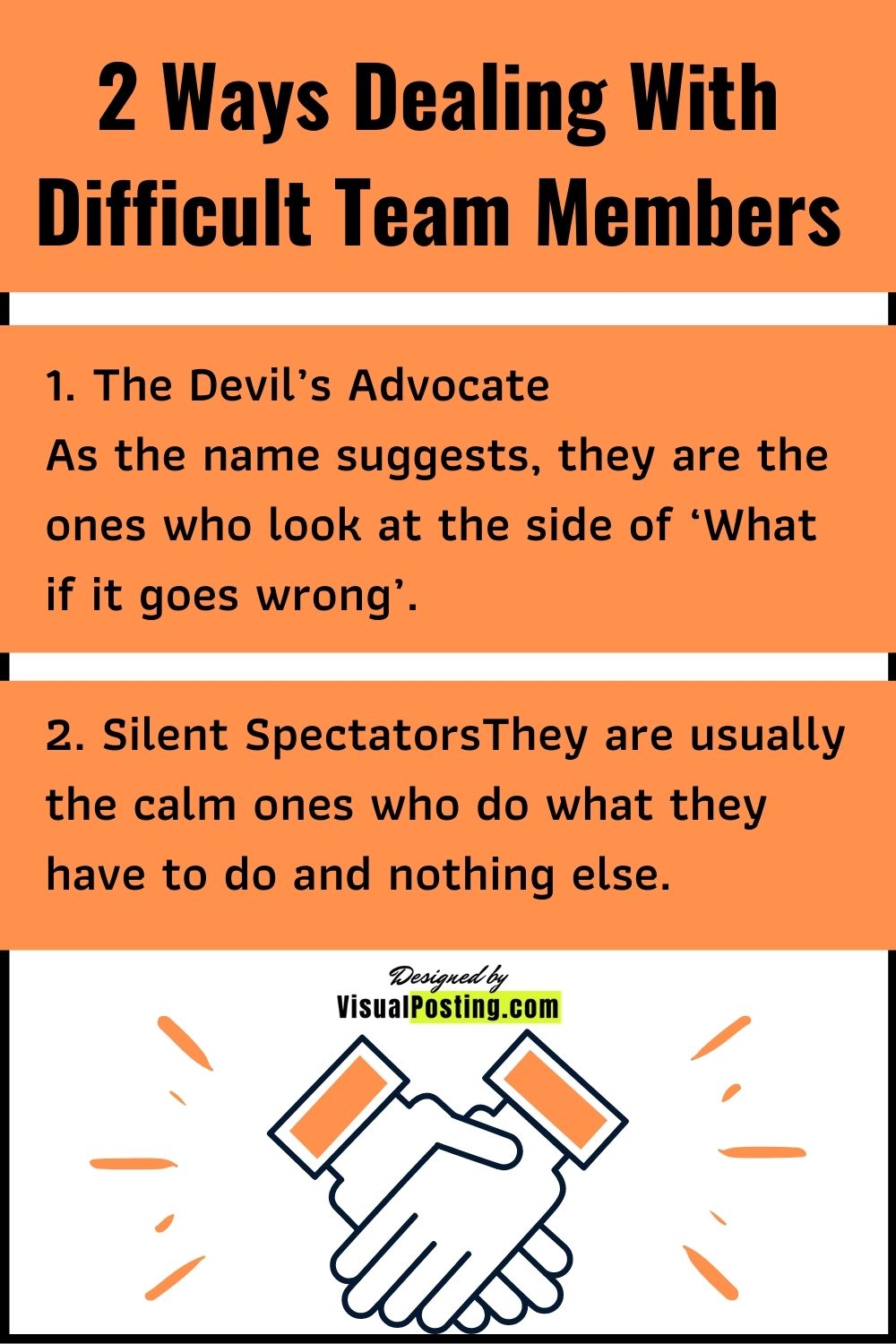
1. The Devil’s Advocate
As the name suggests, they are the ones who look at the side of ‘What if it goes wrong’.
How to handle this difficult team member?
Such an attitude people are good in a way of bringing new perspectives that we would have never thought. Supporting the opposite side and arguing will help the team understand the details even better. They can help us find the things that we missed. They don’t need any special handling. Let them go with the flow.
2. Silent Spectators
They are usually the calm ones who do what they have to do and nothing else.
How to handle them?
Silent spectators or the neutral ones will not hinder fellow team members in any way. Voicing ideas and opinions can be a little less from them. They seem to agree with what has been concluded by the team. They usually play a safe game. You won’t have any trouble handling them. You just have to motivate them a little when needed.
If we look closely, we can see that almost all kinds of difficult team-members fall under these categories. Handle difficult team embers without affecting the team’s performance or morale. The point here is you have to point out the difficult team members and their behaviors. Meanwhile, you have to make sure that they try to change and take it positively instead of creating a big mess.

1. The Constant Challengers of Ideas, Opinions, and Discussions
This attitude can make the team members have mixed feelings of good and bad.
How to Handle such Challenging and Difficult Team Members?
Observe the tone i.e. if it’s in a positive or negative tone. If it is a positive note, then let them place their arguments or challenges over the issue. They should have a valid reason behind it. Give space for them to convey the reason for channeling. If it is a negative note i.e. they simply challenge everything to show their presence or expertise, simply move on. Don’t give more attention to such an attitude.
2. Over-Qualified, Over-Achievers
There’s nothing much we can do about an individual who achieves or qualifies par excellence. But it can create difficulties for other team members.
How to Handle such Challenging Team Member?
Follow the attitude of ‘every team member has their own pace of achieving things’. Bias towards super-achievers should be avoided. Comparisons should be avoided. Make sure that the super-achievers or over-qualified people don’t hurt other team members in any way or show dominance.
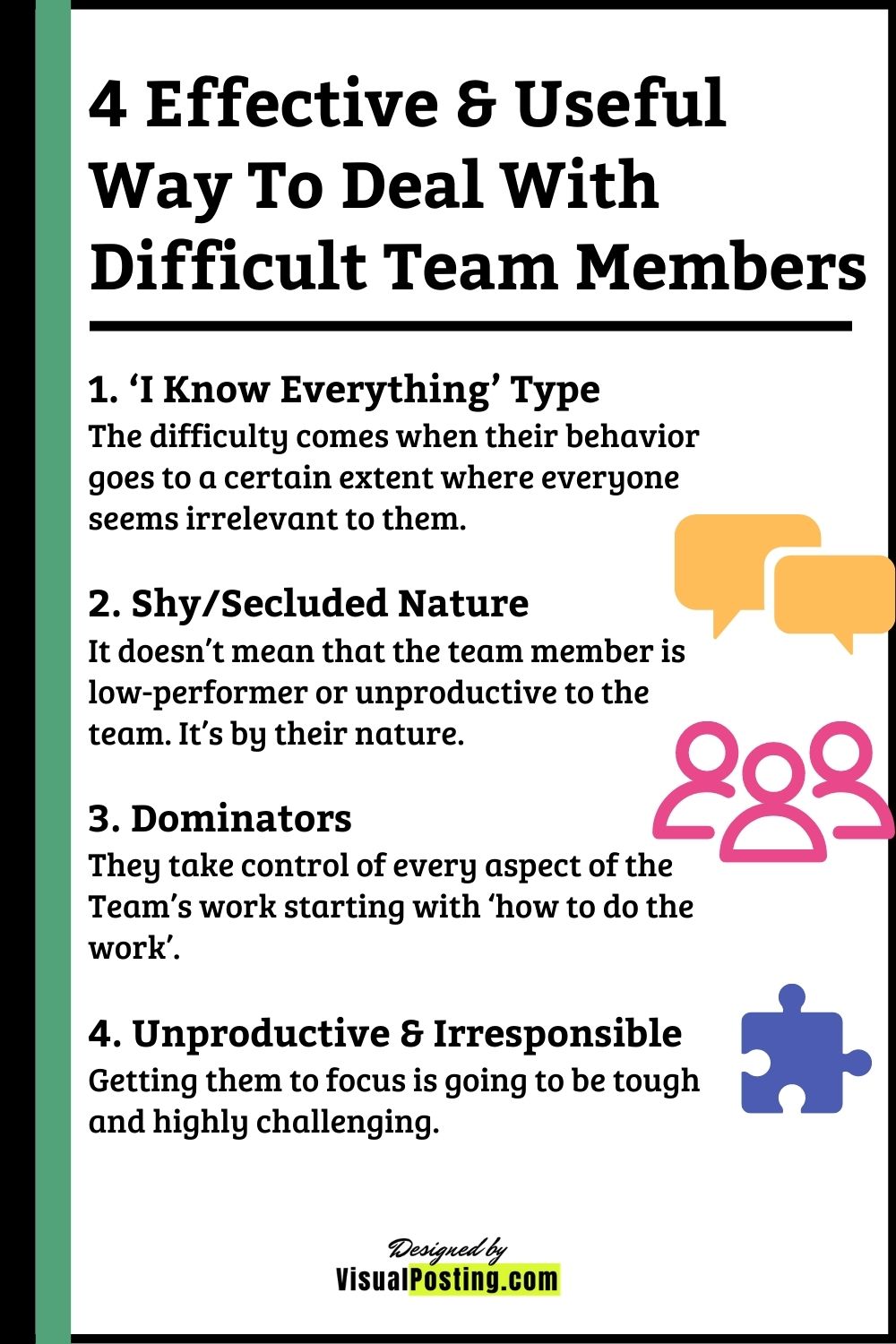
1. ‘I Know Everything’ Type
The difficulty comes when their behavior goes to a certain extent where everyone seems irrelevant to them.
How to Handle this Difficult Team Member?
Ask questions to them like ‘what are you trying to prove here’ or ‘why are you so passionate about this’ or ‘why we have to listen to you’. Discuss with the team and find ways to put the ‘I know everything’ attitude positively.
2. Shy/Secluded Nature
It doesn’t mean that the team member is low-performer or unproductive to the team. It’s by their nature.
How to Handle such Difficult Team Member?
When it comes to Shy/Secluded type of team members, it doesn’t mean they are unproductive. Team members like them can be handled by arranging small groups and discussions. Instead of putting those before the entire team where they tend to shut themselves try this method of handling. Among others, the shy/secluded team members will need time to settle. Try giving them time and observe their progress.
3. Dominators
They take control of every aspect of the Team’s work starting with ‘how to do the work’.
How to handle this difficult team member?
At some point, you have to handle this dominant team member face-to-face. Do it in private. Be direct in explaining their nature and how it is affecting their team and members.
4. Unproductive & Irresponsible
Getting them to focus is going to be tough and highly challenging.
How to Handle this Difficult Team-Member?
Address the issue directly to them. Give your attention. Give them responsibilities that they have to handle every day. Observe how they work. Give them short to long tasks and make them do it in stipulated time. If they remain unproductive and irresponsible even after your intervention, then take it to your immediate head or the HR.
"The road to success and the road to failure are almost exactly the same." -- Colin R. Davis
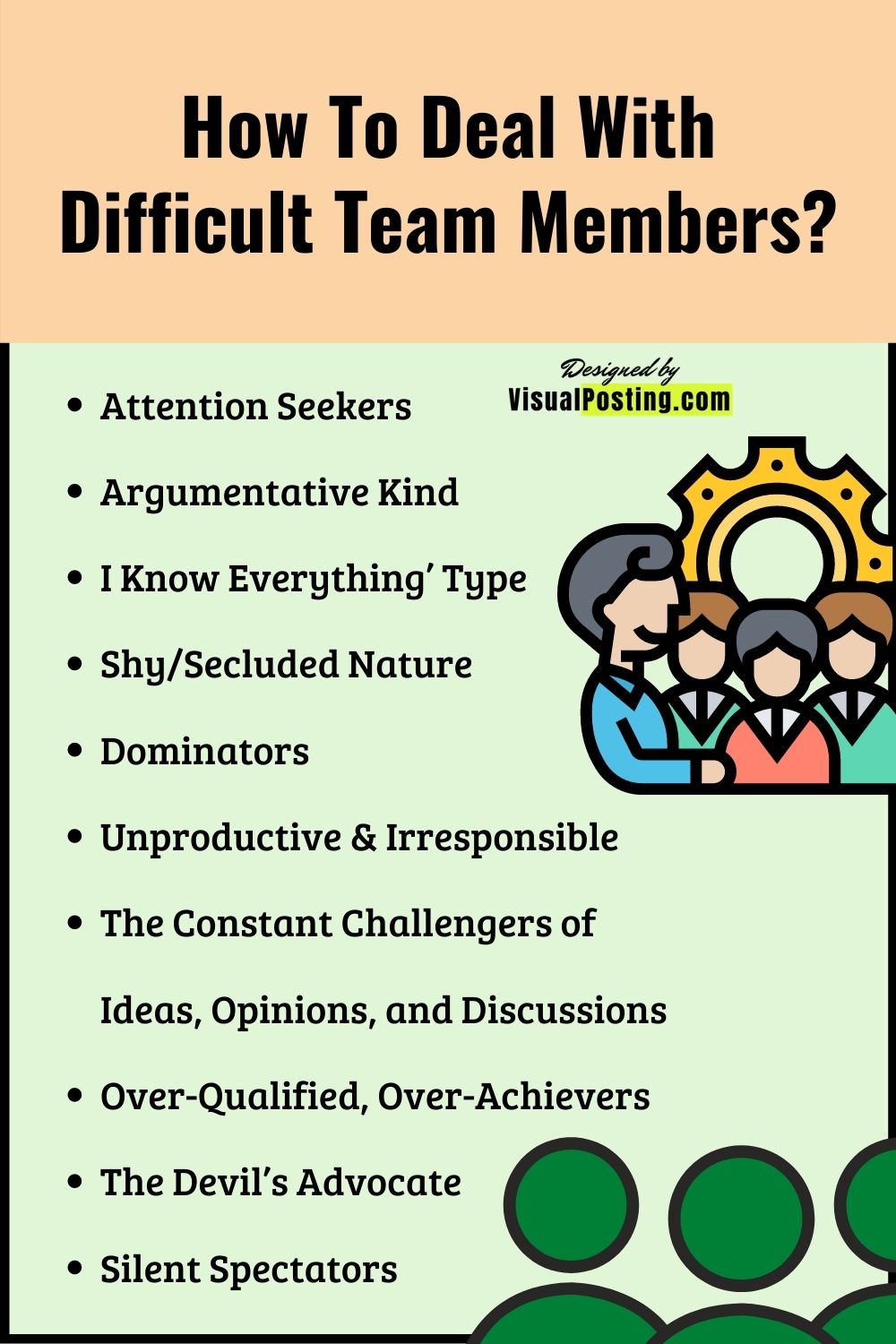
Dealing with difficult team members is challenging. Getting them together along with other members of your team is going to be difficult initially. This is where a team’s leadership skill comes into the scene. Effectively handling difficult team members will add more respect from other people in the team. Before that, observe your team for some time.
1. Attention Seekers
These types don’t care about what’s happening around. All they want is attention. They want to be seen, recognized and appreciated all the time. It is difficult.
How to handle this difficult team member?
Try giving them work in the same pattern of theirs i.e. attention-seeking works like making them open a presentation, or let them keep track of presentation flow or keeping time and such. Handle them by giving works like these. They will feel good as well as not disturb others.
2. Argumentative Kind
All they do is arguing. They argue even in a place where there is no need for any arguments. Other kinds of argumentative people become dominant i.e. they argue for what’s right to them.
How to handle this Difficult Team Member?
When it comes to meetings, presentations or discussions
Make them stop at some point quickly. Tell them to get to the point. Ask them about what they are trying to convey in short. Cut them short to the core instead of letting them argue.
During Work
If they keep arguing for everything like the work assigned, about co-workers or other tasks, at some point you have to deal with this in private. Call them.
Explain to them in private about how their behavior is hindering other team members.
If it’s a valid or positive argument, take it. Else, move on from such argumentative kinds.
Learn strategies for dealing with overpowering personalities on your team. Foster collaboration, communication, and mutual respect for a harmonious work environment.

Don’t Interrupt
This is the part where it gets difficult to handle a dominant team member. Interrupting them only aggravates their behavior. If situations are unavoidable and the dominant team-member has taken the stage, leave it. Don’t interrupt. Don’t let others interrupt too. Let them do what they do. The careless attitude from others will make them step down soon.
Do not show Interest.
Don’t Nod or Smile or accept by shaking or tilting head. Just ignore them. Be neutral without showing any interest. It’s an easy way to handle a dominant team-member. They will eventually step down when they don’t get the attention they seek.
Do the Opposite
Dominant persons will consider everything they said of so much value. Do the opposite here. The more they speak, the less your feedback should be.
Take only the core
Leave the rest and only speak the core issue with them. Let all the unwanted things (they will feel it is important) said by them. The dominant team member will understand.
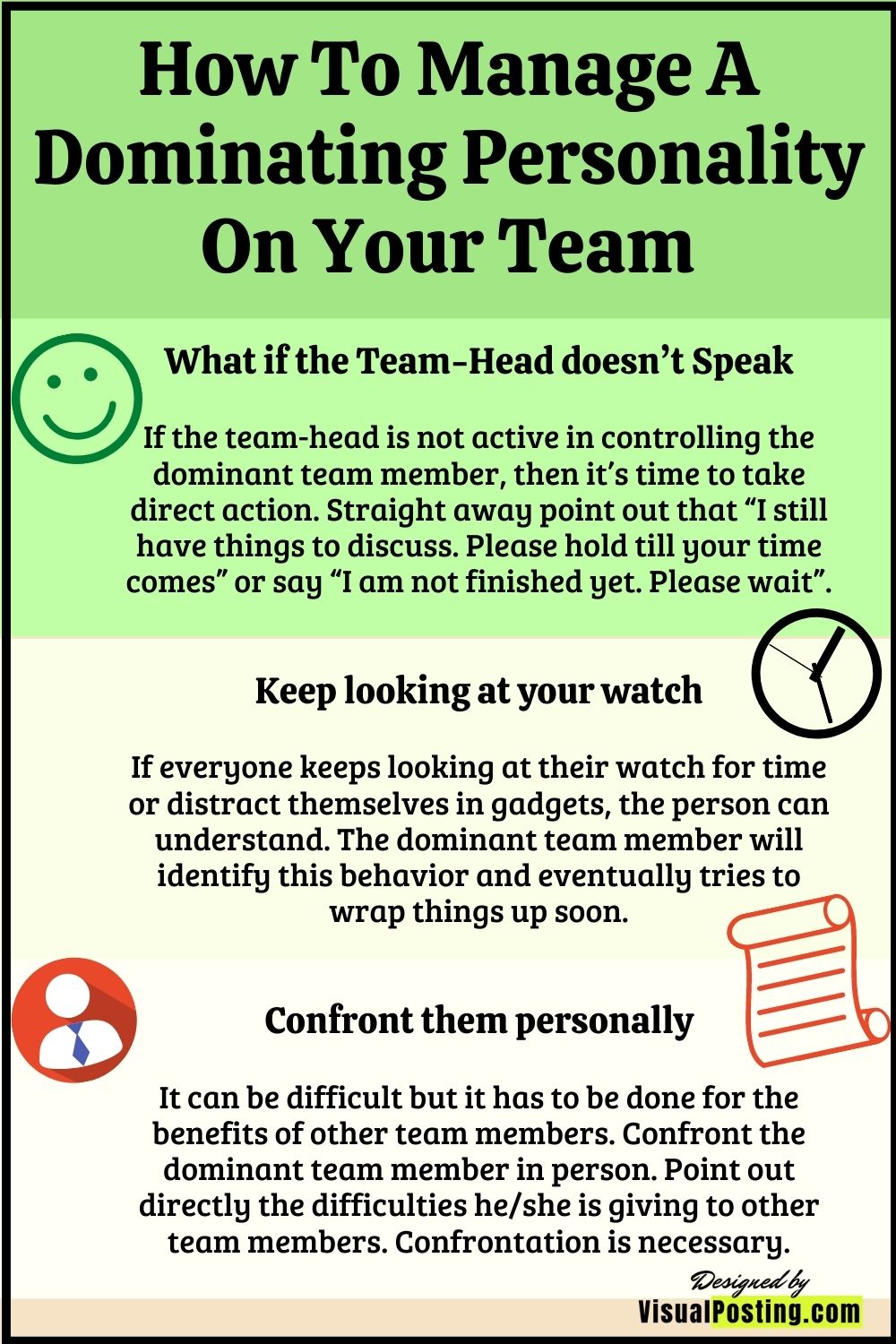
What if the Team-Head doesn’t Speak
If the team-head is not active in controlling the dominant team member, it’s time to take direct action. Straight away, point out that “I still have things to discuss. Please hold till your time comes” or say, “I am not finished yet. Please wait”.
Make them understand that there is a Control.
Any dominant team member will not wait for anyone. They have to take the floor no matter what happens. If so, make them understand that there is still someone top to control.
Often, keep reminding them that other people in a team need space. A manager or team-head should act. If no one interrupts them, they will have a sense of authority.
Keep looking at your watch.
If everyone keeps looking at their watch for time or distracting themselves with gadgets, they can understand. The dominant team member will identify this behavior and eventually tries to wrap things up soon.
Confront them personally
It can be difficult, but it has to be done for the benefits of other team members. Confront the dominant team member in person. Point out directly the difficulties he/she is giving to other team members. Confrontation is necessary.
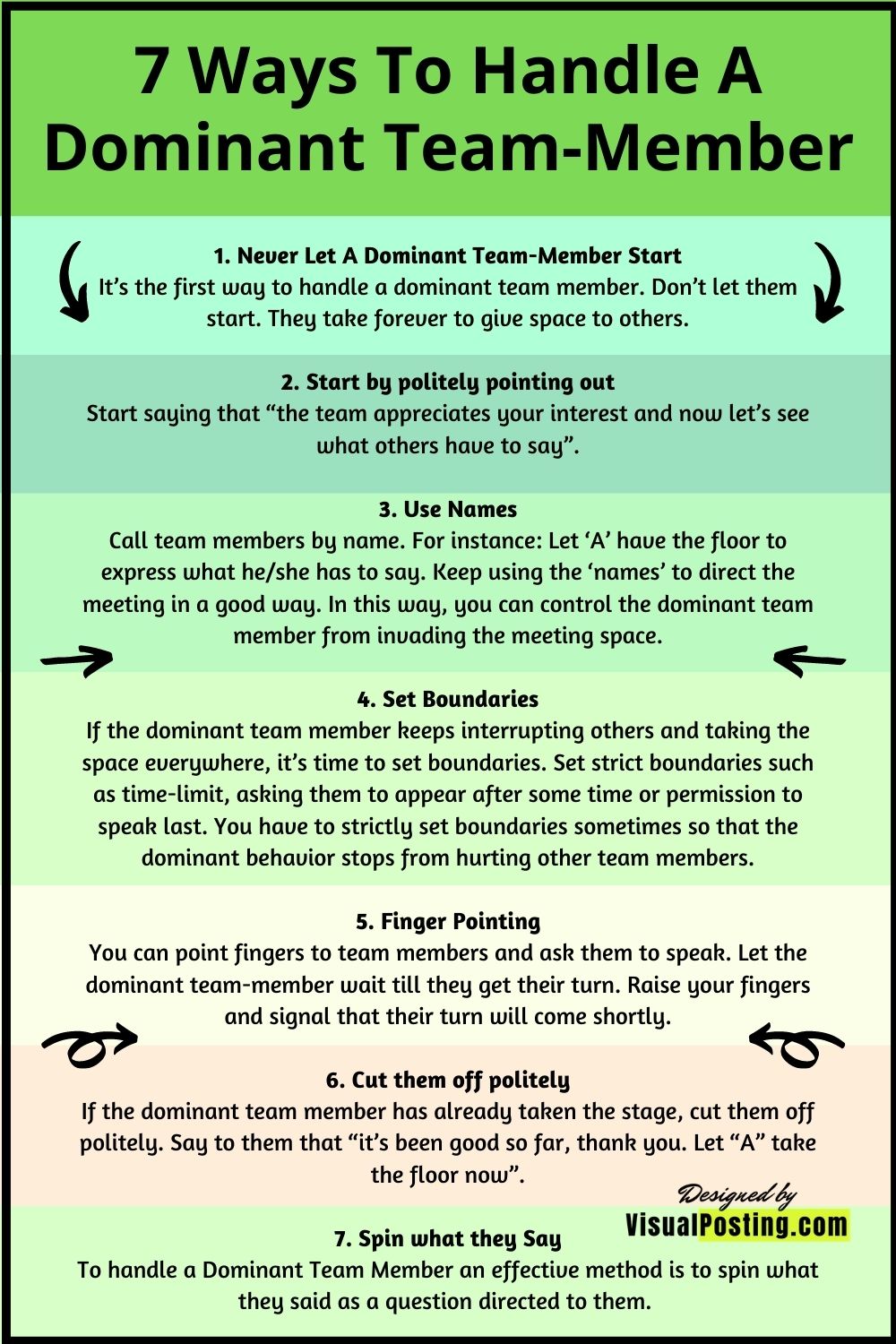
Simple gestures and methods from your side and you can handle dominant team members easily. They are:
1. Never Let A Dominant Team-Member Start
It’s the first way to handle a dominant team member. Don’t let them start. They take forever to give space to others.
2. Start by politely pointing out
Start saying that “the team appreciates your interest and now let’s see what others have to say”.
3. Use Names
Call team members by name. For instance: Let ‘A’ have the floor to express what he/she has to say. Keep using the ‘names’ to direct the meeting in a good way. In this way, you can control the dominant team member from invading the meeting space.
4. Set Boundaries
If the dominant team member keeps interrupting others and taking the space everywhere, it’s time to set boundaries. Set strict boundaries such as time-limit, asking them to appear after some time or permission to speak last.
You have to strictly set boundaries sometimes so that the dominant behavior stops from hurting other team members.
5. Finger Pointing
You can point fingers to team members and ask them to speak. Let the dominant team-member wait till they get their turn. Raise your fingers and signal that their turn will come shortly.
6. Cut them off politely
If the dominant team member has already taken the stage, cut them off politely. Say to them that “it’s been good so far, thank you. Let “A” take the floor now”.
7. Spin what they Say
To handle a Dominant Team Member an effective method is to spin what they said as a question directed to them.

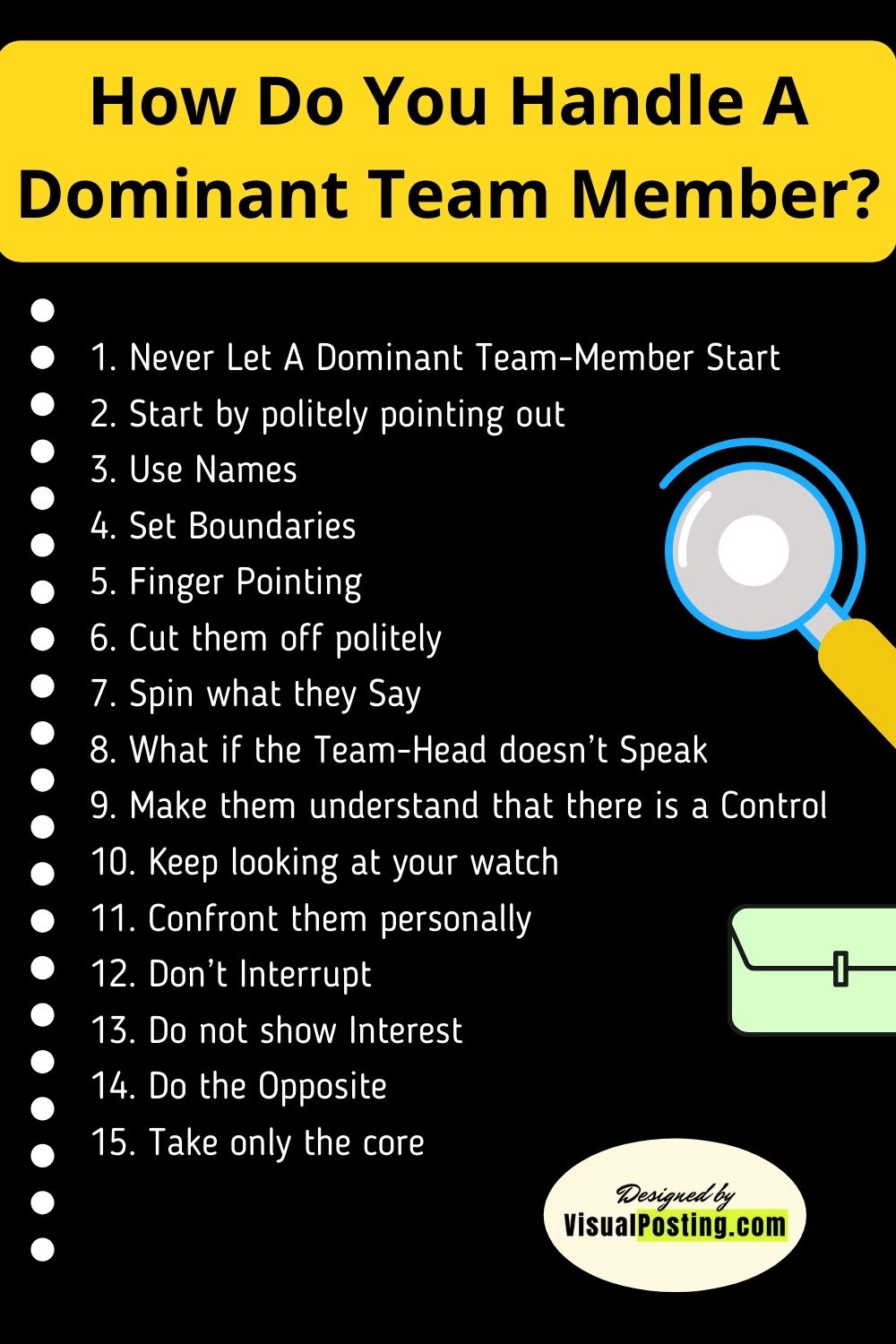
The dominant team member can get into everyone’s nerves easily. Dominant people could hinder the smooth running of a team, even daily. Not just during meetings or any discussions, the dominant team member makes the process a tough one to continue. To handle dominant people, you need to identify them.
How to Identify the Dominant Team Member?
In most cases, you can easily understand a dominant team member. Yet, here are a few pointers that will help you identify a dominant team member easily. They are:
The dominant team-member will not allow other team members to talk until they give the space.
They monopolize discussions, meetings, presentations, and other group activities.
A dominant team member will not like to hear opinions from others.
To a dominant team member, it is their strong self-confidence. But for others, it reflects clearly as arrogance.
They will be direct in conveying things in a harsh method most of the time.
They make quick decisions with no or little input from others.
A dominant team member will always want to be first or begin first in everything.
They show impatience on a large scale. It’s hard to convince a dominant team-member to sit and listen to what others have to say.
15 ways to handle a Dominant Team-member:
1. Never Let A Dominant Team-Member Start
2. Start by politely pointing out
3. Use Names
4. Set Boundaries
5. Finger Pointing
6. Cut them off politely
7. Spin what they Say
8. What if the Team-Head doesn’t Speak
9. Make them understand that there is a Control
10. Keep looking at your watch
11. Confront them personally
12. Don’t Interrupt
13. Do not show Interest
14. Do the Opposite
15. Take only the core
Follow the 15 strategies to handle the dominant team member. Make sure you do it without hurting.
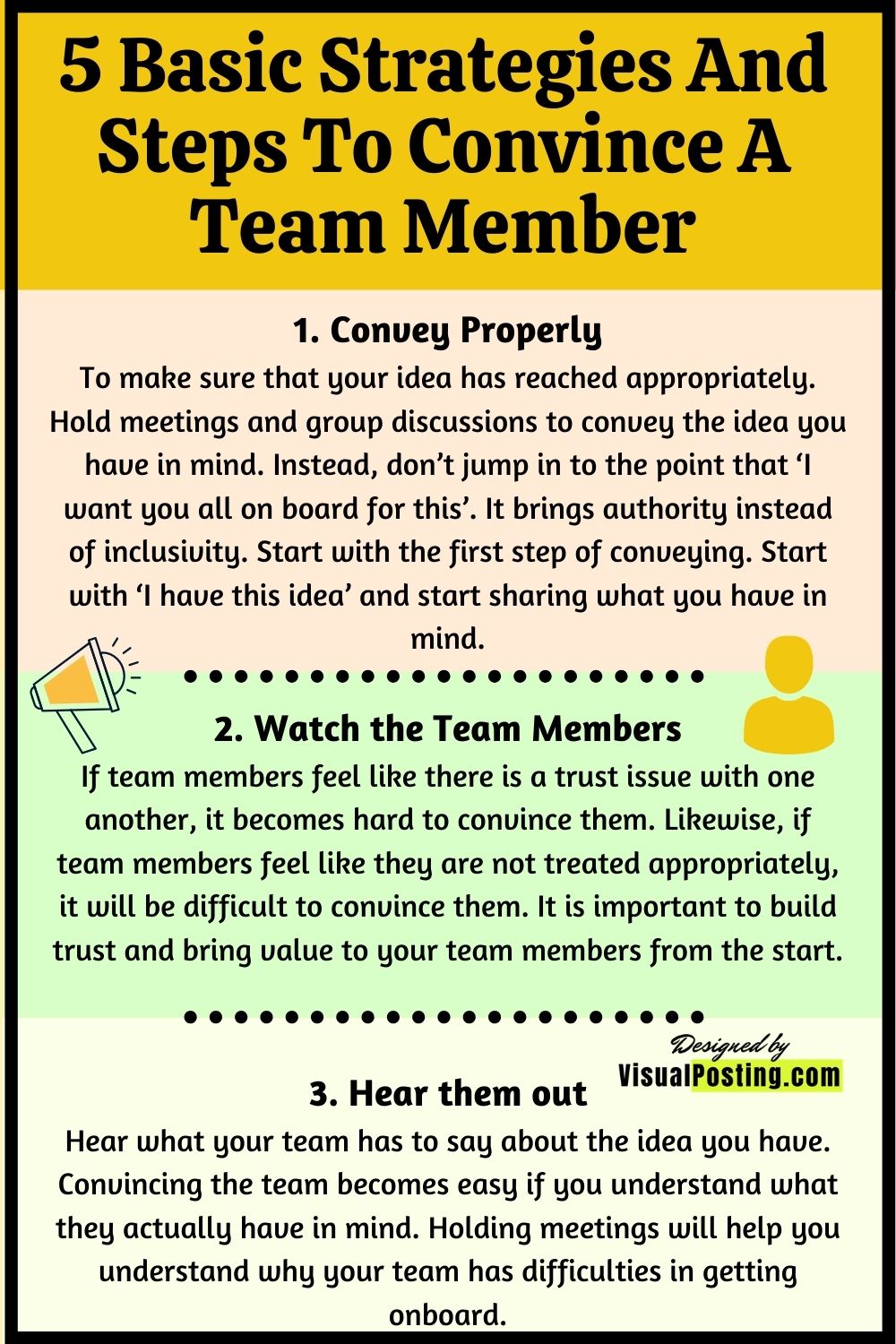
1. Convey Properly
To make sure that your idea has reached appropriately. Hold meetings and group discussions to convey the idea you have in mind. Instead, don’t jump in to the point that ‘I want you all on board for this’. It brings authority instead of inclusivity. Start with the first step of conveying. Start with ‘I have this idea’ and start sharing what you have in mind.
2. Watch the Team Members
If team members feel like there is a trust issue with one another, it becomes hard to convince them. Likewise, if team members feel like they are not treated appropriately, it will be difficult to convince them. It is important to build trust and bring value to your team members from the start.
3. Hear them out
Hear what your team has to say about the idea you have. Convincing the team becomes easy if you understand what they actually have in mind. Holding meetings will help you understand why your team has difficulties in getting onboard.
4. Explain things in a subtle way
When it comes to convincing a team, use subtle ways. Don’t demand. Don’t use the team member’s mistake as a bargaining chip. Don’t bring the team member under any obligations to get onboard.
Sometimes, when people feel like they have no compulsion they automatically tend to get convinced in joining. Convincing the team member has to be in a genuine way so that you can avoid many problems in the future.
5. Discuss the Benefits
To convince a team member, you should be able to show them the benefits first hand. Explain to them the knowledge and exposure they could get. You can convince the team member at the point of earning good credits or chances of promotion or other benefits during meetings and discussions.




